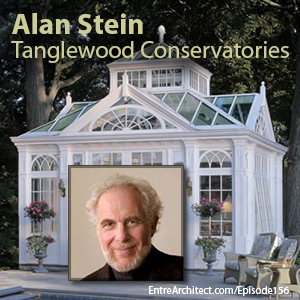 The Architect Specialist
The Architect Specialist
This week on the podcast we have an architect pursuing his dreams, following his passions, serving a market outside the traditional design studio business model and building a successful company.
This week at EntreArchitect Podcast, The Architect Specialist with Alan Stein of Tanglewood Conservatories.
Alan’s Origin Story
As a kid, Alan always loved building things in his dad’s workshop out of anything he could think of. He loved to draw after being enrolled in some anatomical drawing classes; the idea of bringing life to something on a page was fascinating to him. Much later in life, he did a lot of wood working, home construction and cabinet making. He recognized that his skill as a craftsman was lacking the design side.
He went through the architecture program at the University of Maryland and graduated with a degree as an architect. Because he loved making things himself, he didn’t love the traditional architecture path. After working with a design-build firm, he launched into his own design-build practice for some time. One day, a client showed him a picture of an English style conservatory and asked if he could build it. Alan said, “Sure!”
Once they had the job, they hopped on a flight to England to do some research and then completed the project successfully. Following that, they had the same request from a different client. They quickly recognized a market niche and rebranded to go full fledged toward conservatories.
In the beginning, they began by buying parts and pieces from manufacturers, and now they’ve integrated the company to a place where they do the design, engineering, installation, and more for projects all over the world.
How does your process work?
Most of the time, an architect or client approaches Tanglewood Conservatories with an idea. Their design department takes the concept and applies their specialized knowledge. Either the designer has conceived something that’s complicated and unbuildable, creating the difficult task of keeping the concept and making it doable, or architects don’t realize the full capacity of options they have, giving Tanglewood the collaborative process of showing them the different routes they can go from a simple design.
Usually they go from conceptional design to design development as a precursor to construction and manufacturing documents. Once everyone’s in agreement with the design concept and costs, then they can move forward.
Who’s your typical client?
Most of the time architects are clients. The owner calls an architect to build a new house or do a renovation, but Alan’s team is brought in to do the conservatory aspect.
What inspired you to start a company specifically focused on a target market?
The more Alan got to know the rooms and the more research he did on conservatories, the more he fell in love with the concepts. They were the coolest spaces around with tons of glass in the roof and the expressive structure; he loved the fact that one can grow an orange tree in the middle of winter. There’s a wonderful history that he got to know and he fell in love with it. His specific focus and love for the concept allowed him to become an expert in the field.
What were some of the biggest barriers you encountered?
Conservatories were not well-known on this side of the pond, so it was a young market at the time. As they found a measure of success, the competition from the UK became very fierce; at one point they were competing against a handful of companies that were all trying to sell their product to a limited market in the US. Many of those companies no longer exist, which is a true testament to the work that Alan and his team are doing.
Tanglewood Conservatories has always been willing to think outside of the box. Although there’s a typical conservatory image, they began to push the envelope there by working more with steel structures in wood rooms or doing interesting work with copper or bronze, always looking for things that were more unique. One project they completed was a greenhouse outside of Boston, using some techniques that had never been used before. The client wanted references for similar projects, and Alan had to let him know that he wasn’t able to because that was the first time they were creating that type of project. Though many of their ideas are innovative, they’ve developed the awareness and the systems to allow them to successfully pursue new technologies and design features and be able to consistently pull them off successfully.
Do you think some of your success was the result of you being an architect first?
Because Alan was focused on design first, his architecture background has driven a lot of success. It’s also differentiated his team in the market between companies who are in manufacturing more than the foundation of design. There have been times they’ve sacrificed potential profitability for the sake of design.
Was there a turning point going from a startup to a successful company?
There wasn’t one specific point, but rather a gradual path. As they’ve developed the steel side of the business, a lot of small steps have made the journey possible.
What does your team look like?
There are 30 people in house and many outsourced partners. There’s a drafting and engineering staff, two other designers, a production team and outsourced help for installation and production of parts along with the administrative side of the business.
What is the one thing that small firm architects can do today to build a better business tomorrow?
“Bring in experts early. Don’t think you can do everything yourself. The world has changed; building and business are much more complicated. On the technical side or or the business side, bring in someone who can help push things forward, reach out and get the help that you need early. By yourself, you have limited capabilities. If you want to grow a successful business, you have to bring in a lot of people with a lot of experience to help you.” – Alan Stein, Tanglewood Conservatories
Connect with the Alan online at TanglewoodConservatories.com or find him on Facebook, Twitter, and Pinterest.
Visit our Platform Sponsors
NCARB is helping architects reach their goals! Get back on track with the new AXP (Architectural Experience Program) Portfolio by submitting an online portfolio and meeting your state’s requirements to get one step closer to becoming an architect! Visit NCARB.org to learn more today.
TruStile is a leader in high end, architectural interior doors that never fail to perform. They’re passionate about providing inspiration and tools to transform your designs with the most authentic and distinctive doors available. Visit them at TruStile.com to learn more!
Freshbooks is the easy way to send invoices, manage expenses, and track your time. Learn more at FreshBooks.com.
Access Your 30-Day Free Trial at FreshBooks.com/architect (Enter EntreArchitect)
Referenced in this Episode
EntreArchitect Profit for Small Firm Architects course (free)
The post EA156: The Architect Specialist with Alan Stein [Podcast] appeared first on EntreArchitect // Small Firm Entrepreneur Architects.
